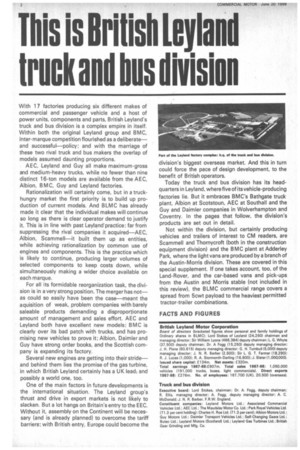This is British Leyland truck and bus division
Page 4

If you've noticed an error in this article please click here to report it so we can fix it.
With 17 factories producing six different makes of commercial and passenger vehicle and a host of power units, components and parts, British Leyland's truck and bus division is a complex empire in itself. Within both the original Leyland group and BMC, inter-marque competition flourished as a deliberate— and successful—policy: and with the marriage of these two rival truck and bus makers the overlap of models assumed daunting proportions.
AEC, Leyland and Guy all make maximum-gross and medium-heavy trucks, while no fewer than nine distinct 16-ton models are available from the AEC, Albion, B MC, Guy and Leyland factories.
Rationalization will certainly come, but in a truck-' hungry market the first priority is to build up production of current models. And BLMC has already made it clear that the individual makes will continue so long as there is clear operator demand to justify it. This is in line with past Leyland"practice: far from suppressing the rival companies it acquired—AEC, Albion, Scannnnell—it built them up as entities, while achieving rationalization by common use of engines and components. This is the practice which is likely to continue, producing larger volumes of selected components to keep costs down, while simultaneously making a wider choice available on each marque.
For all its formidable reorganization task, the division is in a very strong position. The merger has not— as could so easily have been the case—meant the aquisition of weak, problem companies with barely saleable products demanding a disproportionate amount of management and sales effort. AEC and Leyland both have excellent new models: BMC is clearly over its bad patch with trucks, and has promising new vehicles to prove it; Albion, Daimler and Guy have strong order books, and the Scottish company is expanding its factory.
Several new engines are getting into their stride— and behind them lies the promise of the gas turbine, in which British Leyland certainly has a UK lead; and possibly a world one, too.
One of the main factors in future developments is the international situation. The Leyland group's thrust and drive in export markets is not likely to slacken. But a lot hangs on Britain's entry to the EEC. Without it, assembly on the Continent will be necessary (and is already planned) to overcome the tariff barriers: with British entry, Europe could become the division's biggest overseas market. And this in turn could force the pace of design development, to the benefit of British operators.
Today the truck and bus division has its headquarters in Leyland, where five of its vehicle-producing factories lie. But it embraces BMC's Bathgate truck plant, Albion at Scotstoun, AEC at Southall and the Guy and Daimler companies in Wolverhampton and Coventry. In the pages that follow, the division's products are set out in detail.
Not within the division, but certainly producing vehicles and trailers of interest to CM readers, are Scammell and Thornycroft (both in the construction equipment division) and the B MC plant at Adderley Park, where the light vans are produced by a branch of the Austin-Morris division. These are covered in this special supplement. If one takes account, too, of the Land-Rover, and the car-based vans and pick-ups from the Austin and Morris stable (not included in this review), the BLMC commercial range covers a spread from 5cwt payload to the heaviest permitted tractor-trailer combinations.
FACTS AND FIGURES










































































































































































































































































